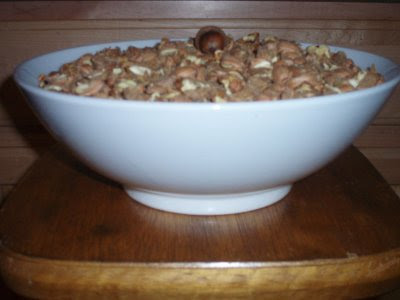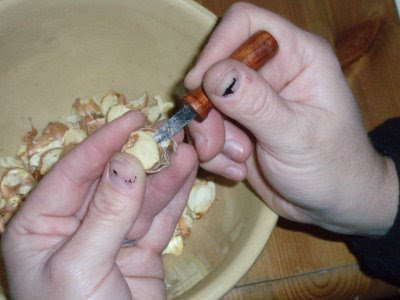Living in Maine, the Oak tree that gave me my acorns is a Red Oak. Therefore it has more tannic acid in it that the White Oak. I am nearly done shelling the acorns and am preparing for the next step. Everybody's friend Google led me to a Maine Guide page. Since this is my first time on such a sustainable measure, I think taking it from a seasoned pro at this is best. Dan Fisher provides immense detail and offers a quite interesting natural history of the use of acorns. Thanks Dan!
http://www.jackmtn.com/acornbread.htmlAcorns and Acorn Bread by Dan Fisher
On a windy day in September I took time out from work to go on a day hike with two friends, Dave and Eric. We climbed Mt. Megunticook in Camden, and traversed some of the nearby trails. Eric and I stopped often to stuff some of the abundant acorns into my day pack. This year (1997) there seems to be a good crop of acorns. Some people say that a lot of acorns mean the winter will be a harsh one.
Acorns and oaks have a multitude of uses. All types of acorns throughout the country are edible. In south coastal Maine, where I live, the most predominant oak is the Red Oak. Acorns from the Red Oak group have a lot of tannic acid in them that must be leached out to make them edible. Although the leaf shapes of the trees in the Red Oak category vary somewhat, the end of the leaf lobes on all of these oaks are pointed. All of the oaks in the White Oak group have leaves with the ends of the lobes rounded. Acorns from the White Oak group need little or no processing. They have a low tannic acid content, and are naturally sweet. I've been in areas of Arizona where most of the oaks were sweet and I was able to pick the acorns off the ground and eat them as a tasty ready-to-go treat.
There are several reasons White Oaks are few and far between in my neck of the woods. They can take as long as fifty years to produce acorns. When the acorns fall to the ground they are the preferred food of many animals including deer, turkeys, grouse, squirrels, chipmunks and more. Squirrels are known to eat the White Oak acorns first and bury the Red Oak acorns for later in the winter or spring. Over time some of the bitterness is leached out of the acorns by the moisture in the ground, aided by snowmelt and rain.
In some areas of the country, even in recent history, acorns were a staple food for native peoples. Over the course of history it has been estimated that many more millions of tons of acorns have been consumed by humans than wheat, rice, and other grains.
Acorns can easily be processed into nutritious flour. First they must be shelled. A fist sized rock works great as a nutcracker. After I shell them I like to crush the acorn meats into smaller pieces before boiling. This allows the tannic acid to be leached out more quickly.
Take the shelled, crushed acorn meats and put them into a pot of already boiling water. As the acorns boil the water will become discolored. When the water is dark brown (every ten minutes or so of boiling), strain out the acorn meats and switch them to another pot of already boiling water. Continue this process until the nutmeats no longer taste bitter. I generally do 3 or 4 water changes. The amount of boiling you do will vary depending on your acorns and your patience. I've made sweet tasting acorn bread with acorn meal that still had some bitterness to it. Experiment.
When switching the acorns from one pot of water to another, make sure the water is boiling before adding the acorns. Switching the acorns from boiling water to cold water seems to lock in the bitterness. When most of the bitterness is gone from the nutmeats, the meats can be crushed into a meal or mush. The wet meal can be used right away in a bread recipe, or dried and stored as flour is. It will keep as long as flour does if kept dry.
I mix a lighter flour such as cattail or wheat flour with the acorn meal when making bread. Acorn flour is heavy and the bread may fall apart if not made of a mixture of flours. White flour, corn flour, and soy flour all will do.
Another way to leach out tannins from acorns is to put them in a mesh sack and leave them in a running stream for a week or so. The length of time and results will vary depending on the acorns, the water temperature and flow rate, and other factors.
If you use the boiling method don't throw away the brown water. This water is a tannic acid solution that has a variety of uses. It can be used as a dye for clothing. When used this way it needs a fixer or the color will fade after washing. The tannic acid can also be used as a laundry detergent. Put a couple of cups of the solution in each load of wash. It cleans well, and the clothing will smell great, but it will color whites a slightly tan color.
The solution is antiviral and antiseptic. It can be used as a skin wash for rashes, skin irritations, burns, poison ivy, cuts, etc. It can be gargled for sore throats or taken as a mild tea for diarrhea and dysentery, or used externally on hemorrhoids. Store jars of tannic acid solution in jars in the refrigerator. If mold forms on top after time, the solution can be reboiled to kill the mold and stored again.
Animal hides can be tanned more easily by soaking them in the tannic acid from the acorns. Hide tanning is the process of making a raw animal skin into a comfortable, pliable, durable piece of clothing. The use of the boiled brown acorn water in producing "tanned" hides is why we call this water tannic acid.
The notes below were written by Tim Smith.
While the season for poison ivy is just about behind us, the season for acorns is in full swing. Many people have heard that acorns can be eaten, and a few have actually put them in their mouths, only to spit them out while their faces puckered up. This is due to the tannic acid in the acorns, which much be leached out. To do this, bring a large pot of water to a boil, then dump in the shelled acorns. Let them boil until the water turns a dark color, then remove the acorns and put them into another pot of clean, boiling water. Continue this process until they no longer have the puckering effect when you chew on them. Then use them for snacks, grind into flour, or use any way you please. It is important to put them into boiling water for good-tasting acorns, as putting them into a pot of cold water, then bringing it to a boil tends to lock in the tannic acid. Don't throw out the water, as it is naturally astringent (contracts or tightens up tissues) and great for the skin. By now you might be curious how this relates to poison ivy. The connection is that acorn water is amazingly effective in eliminating it. A recent discussion with a quick-witted summer camp director from Pennsylvania confirmed my anecdotal evidence. I was informed that it had eliminated symptoms in 95% of cases at his camp within three days. The method used in this case was to pour the acorn water into ice trays and freeze, then rub the ice on the affected area. Cold also helps with inflamed tissues, making the ice an ideal delivery mechanism. If you grind the acorns into flour you can make delicious and nutritious acorn bread. Here's how:
50% or less Acorn flour (if you use more than 50%, bread will be too crumbly)
50% or more wheat (preferably whole wheat) flour
a bit of fat (olive oil, bear grease, butter, or whatever you have)
1 teaspoon of baking powder for each cup of flour
If you don't grind the acorns well, you have nut bread, so there's no need to be overly assiduous. Mix the ingredients, add enough water for a clay-like dough, and bake until done. To test if done, get a stick and push it into the center of the loaf. If it comes out clean and dry, it's done. If it comes out wet and sticky, it needs to cook more. Cooking time depends on temperature, size of the loaf you're making, and how wet the dough is. If you do it a few times, you'll get it right.


 See what happened was that I actually put them all in at once, on three different sheets, and that proved to give off far too much moisture at once and therefore not really work at all. I love learning by trial and error. I also know that the silly little book I am following lacks a lot of wordage that I know feel needs to be put into the book. I think starting with one cup of acorns would probably be the best direction I would add.
See what happened was that I actually put them all in at once, on three different sheets, and that proved to give off far too much moisture at once and therefore not really work at all. I love learning by trial and error. I also know that the silly little book I am following lacks a lot of wordage that I know feel needs to be put into the book. I think starting with one cup of acorns would probably be the best direction I would add.










































